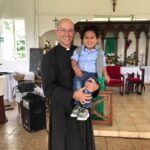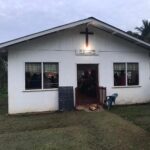January 31st, 2021
Greetings to all from “Beautiful Guyana”!
My two week visit to our novitiate house and parish in Charity has turned into much more than expected. I was asked to come during the seminary’s Christmas break to teach a class to our three seminarians here, Kevon, Sherlon and Daniel.
The first day here was already a foreshadowing of things to come. I arrived on Christmas Eve in the afternoon. I was asked to offer the Mass at Charity that evening, while our other priests here in Charity went to offer the Masses along the Coast. When Fr. Willian returned later that night he told me that he was too sick to continue on Christmas Day and that I would need to cover his Masses along the river. Thus, I was immediately thrown into the “missionary adventure” we could say. Christmas Day I went up the Pomeroon to offer two Masses, one at the Siriki mission post and the other at Arapiako. The communities were both enthusiastic about the celebrations and grateful that we came. That was on Friday. On the following Sunday I accompanied Fr. Willian, who was well rested by then, to help with Masses in Marlborough, where Kevon is from, and St. John’s, Damian’s home parish. It rained practically the whole boat ride there. I was soaked for both Masses. Since Guyana is known as the “land of many waters”, it was a nice Guyanese welcome.
After these unexpected events, the next week and a half went as planned. I taught Anthropology to the three seminarians and also began giving Latin and Sacred Chant classes to them and Scott our novice from Santa Rosa. When our two weeks of classes were through, I was supposed to return to the seminary. However, the novitiate/seminary community was planning a mini-Convivencia outing to Hosororo for the following week. I was graciously given the chance to extend my stay for two more weeks.
Hosororo was another adventure. We traveled on Sunday, January 9th to Santa Rosa spending the night at our mission en route to Hosororo the next day. From Santa Rosa to Hosororo, it was supposed to be a four and a half hour trip. It turned into almost a seven hour trip. On two different occasions we had engine trouble which cost us a considerable amount of time. Our delay also meant that we had to start navigating the river in the dark. In addition, the seminarian in the lead boat (that is, the only one who actually knew how to get to Hosororo) misunderstood Fr. Willian’s directions and sped on ahead of us creating such a distance between us, that we lost contact with one another. By the time our boat reached the mouth of the bay leading out to the Atlantic our lead boat was nowhere to be found. Thus, we had to continue entering the bay slightly and then turning up what we hoped to be the mouth of the Waini River leading us to Kumaka and Hosororo. Providentially a fishing boat was out on the water that night and confirmed for us that we were heading the right direction. Slowly but surely we made our journey up the river.
When we finally reached the port town of Kumaka, which is below Hosororo Hill it was 8:30pm. We hoped we would find the other boat already there. They were nowhere to be found. The layman from Hosororo who had coordinated everything with Fr. Willian met us and took us to the parish. Some youth from the parish waited at the landing to see if the other boat would arrive. By 10:00pm there was no sign of them. Since we knew they had very little gas we assumed that they had just stopped along the river for the night. The next morning after Mass we would go out to look for them.
Providentially, there was no need to send a search party. They arrived the next morning at 6:00am; hungry, sleepless and mosquito-bitten.
Why I am including all of this? Well, it was our stay in Hosororo that explains my even longer stay in Guyana.
The village of Hosororo lies in the northwestern region of Guyana. It belongs to what is known as “Region 1” and sits on top of Hosororo Hill. The whole area is very different geographically from our other missions. There are many hills in this area which makes traveling by road as necessary as by boat.
Although the beginning of the Church in Guyana dates as far back as the 1780’s, the Church did not begin to establish organized missions until 1822. The Jesuit Mission in Region 1 began in the early 1900’s at Morawhanna, but moved to Hosororo in 1935. In its beginnings it comprised ten mission stations or chapels and at its height grew to 30 missions stations. Today, the mission center at Hosororo cares for 21 chapels, thus the priest is always on the “go” we could say.
As one Jesuit wrote, “The Lord said, Go ye and teach all nations. A mighty lot could be said on the word Go…We were always going: going into every nook and corner to let the people see the priest, hear Mass and receive the sacraments.” Unfortunately, these same Jesuits who went to every corner of Region 1 have since left the mission. For almost a year now there has no permanent presence of a priest. This reality is what literally broke my heart after Fr. Willian and I met with some lay leaders in the parish and the Missionaries of Charity who have a convent next door.
For more than a year, children have gone unbaptized and waiting to receive First Communion. For more than a year some communities have gone without a priest to offer Mass and hear confession. For more than a year these untiring lay people and sisters have tried to hold together their Catholic communities and all of them repeated the same thing, “We are like sheep without a shepherd.”
So, before we returned to Charity, I did the only thing I could do at the moment, I asked to stay longer. Permission was granted, and on Monday of this past week I arrived back to Hosororo with two of the seminarians.
After a week of cleaning up the rectory, reviewing Anthropology with the seminarians before their final test, and offering daily Masses, we began our pastoral work here in the surrounding region of Hosororo for the time being. On Saturday afternoon we travelled to two of the hill communities—Barabina and Mabaruma Settlement—for vigil Masses and today after Mass in Hosororo we went to Mabaruma and Kumaka. Today I also had my first Baptism and a several visits to the sick. One old man in his late 80’s was so happy to see us. He told me, “Father, it’s been a long time since I saw a priest. When are you coming back?”
What a joy it is for a priest to hear those words! What a joy it is to live the priesthood that God has gifted us with!. The happiness of a missionary priest is dependent upon living what you are. If you can live the priestly identity you are being formed in—an identity that we know our patron teaches us means being a priest and a victim—the struggles, the inconveniences, the tests of patience that come with being in the mission are all worth it. Try to be someone and something other than a religious priest in the mission and you will be miserable and suffer a crisis of identity. But to finish on a happy note, as priests and religious we should never have to suffer a crisis of identity if we know that “who we are” is really rooted in “Whose we are”.
God bless you and God love you.
Long live the mission!
Long live the Institute!
And long live the “Fulton Sheen” and its future missionaries!
Fr. Christopher Etheridge, IVE
Hosororo, Guyana









